As an Amazon Associate KitchenwareSets.com earns from qualifying purchases.
11 Stunning Cottage Core Kitchen Ideas For A Dreamy Space
Dreaming of a kitchen that feels like a warm, storybook hug? A space where the scent of freshly baked bread seems to hang in the air, even when the oven is cold? You’re not just looking for a new design; you’re craving a feeling—a cozy, charming escape from the hustle of modern life.
You scroll through endless photos of beautiful kitchens, but they often feel sterile or unachievable. You want a space that feels personal, lived-in, and full of character, not a showroom replica. The challenge is figuring out how to translate that dreamy, nostalgic feeling into practical, actionable steps for your own home, without it feeling cluttered or chaotic.
The answer is to embrace the cottagecore kitchen aesthetic, a design style that celebrates a romanticized vision of rural life. It’s all about blending natural materials, cozy textiles, vintage finds, and a warm, earthy color palette to create an inviting, nostalgic, and functional heart for your home. Here’s your comprehensive guide, curated from extensive research into the top design trends for 2025, with 11 stunning and achievable ideas to get you started.
Dreaming of a Kitchen That Feels Like a Warm Hug?
Are you tired of sleek, minimalist kitchens that feel more like a laboratory than the heart of the home? You’re not alone. There’s a growing desire for spaces that are warm, inviting, and full of personality. This is where the magic of cottagecore comes in. It’s more than just a trend; it’s a return to simplicity, a celebration of nature, and a deep appreciation for the handmade and the historic.
This guide is designed to be your ultimate resource. We’ll walk you through the core principles of the aesthetic and then dive into 11 beautiful, practical ideas you can mix and match to create the cottage kitchen of your dreams. Get ready to fall in love with your kitchen all over again.
What is the Cottagecore Kitchen Aesthetic?
A cottagecore kitchen is a design style that blends rustic, French vintage, and shabby chic elements to create a warm, cozy, and functional space. It’s characterized by its use of natural materials, charming patterns, and vintage decor, all inspired by a romanticized and nostalgic idea of simple country living.
At its core, the cottagecore kitchen aesthetic is defined by a few key principles:
- A Focus on Nature: Think natural wood, stone, fresh herbs on the windowsill, and bouquets of wildflowers from the garden. It’s about blurring the line between indoors and outdoors.
- Nostalgia for a Simpler Time: This style evokes a sense of history. It embraces imperfections like chipped paint, worn wood, and tarnished brass, as they all tell a story.
- Emphasis on Handmade & Vintage: From hand-thrown pottery to thrifted copper pots and embroidered tea towels, the decor feels collected and personal rather than store-bought and uniform.
- Creating a Cozy, Functional Hub: Above all, a cottagecore kitchen is meant to be used and loved. It’s a practical workspace for baking, cooking, and gathering, where beauty and function go hand-in-hand.
11 Stunning Cottage Core Kitchen Ideas For a Dreamy, Lived-In Space
Ready to transform your kitchen into a charming, lived-in sanctuary? Here are 11 distinct and beautiful ideas that cover everything from major design elements like cabinets and sinks to the small decorative touches that truly bring the cottagecore spirit to life. These ideas, curated based on trending designs for 2025 and feedback from home decor enthusiasts, can be adapted for any space or budget.
1. Embrace Rustic Open Shelving
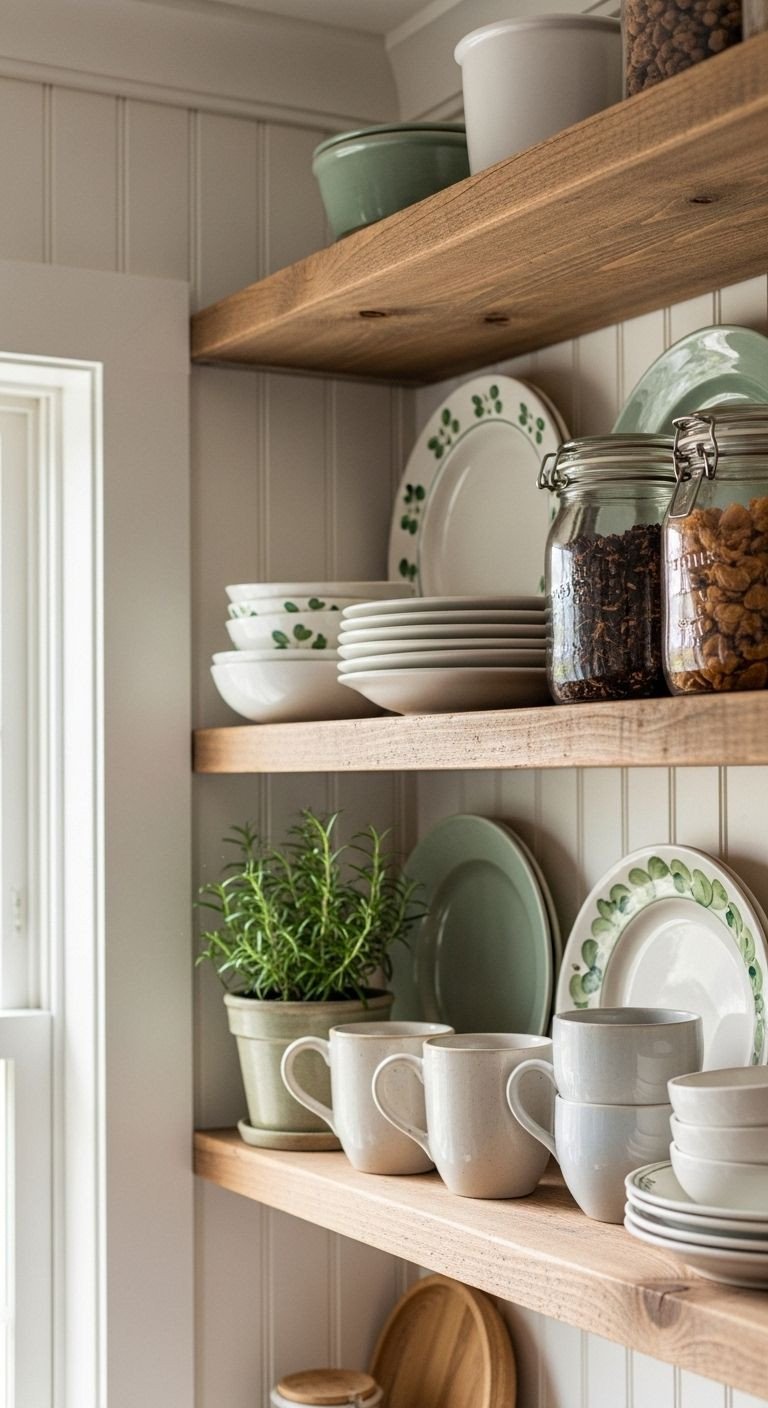
The best way to achieve a classic cottagecore look is by swapping upper cabinets for rustic open shelving made of natural or reclaimed wood. This approach not only opens up the space and makes it feel airier but also provides the perfect stage to display your favorite everyday dishes, ceramic mugs, and glass storage jars.
- Materials Needed: Reclaimed wood planks or thick pine boards, heavy-duty shelf brackets (iron or brass), stud finder, drill, level, measuring tape, sandpaper.
- Step-by-Step Directions:
- Decide on placement, ideally replacing a set of upper cabinets. Use a stud finder to locate wall studs for secure mounting.
- Measure and cut your wood planks to the desired length. Sand the edges for a smooth finish. You can stain or wax them to enhance the natural grain.
- Install the brackets first, using a level to ensure they are perfectly straight.
- Place the wooden shelf on top of the brackets and secure it from underneath.
- Style your shelves with everyday ceramic dishes, mixing bowls, and glass jars. Don’t overcrowd them; leave some breathing room.
Pro-Tip: For a truly authentic look, source brackets from an antique shop or use simple, black iron brackets. In my experience, the slight imperfections in vintage hardware add so much more charm than something brand new.
Pin this shelf styling inspiration for your kitchen makeover!
2. Install a Charming Farmhouse Sink (with a Skirt!)
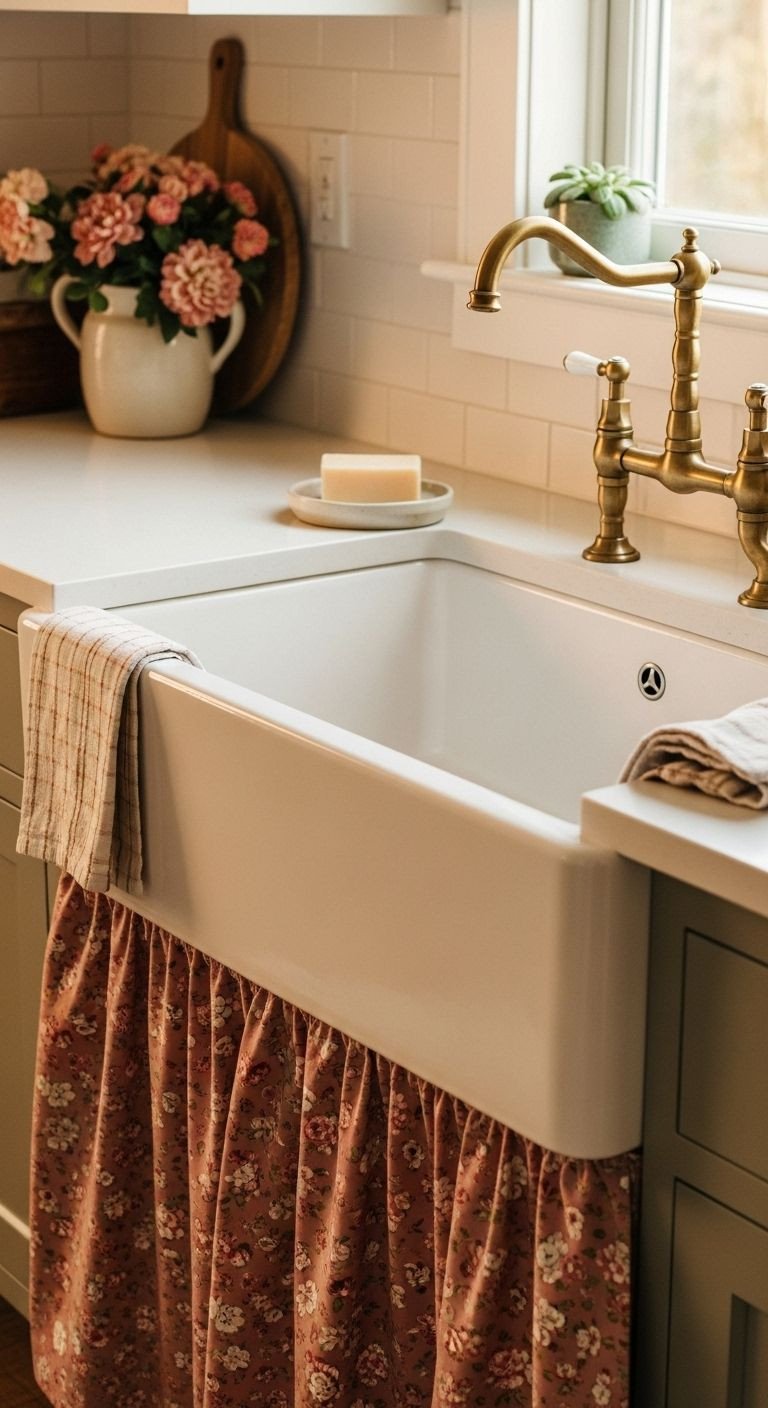
Nothing says “cottage kitchen” quite like a deep, apron-front farmhouse sink, especially when paired with a quaint fabric skirt below. The sink itself is a timeless, practical centerpiece, while the skirt adds a touch of softness, hides clutter, and provides an opportunity to introduce a charming floral or gingham pattern.
- Materials Needed: Fabric of choice (linen, floral cotton), tension rod or adhesive hook-and-loop strips, measuring tape, scissors, sewing machine or iron-on hem tape.
- Step-by-Step Directions:
- Measure the width of the area under your sink and the desired height from the countertop to the floor.
- Cut your fabric, adding 2 inches to the height for the hem and rod pocket, and multiplying the width by 1.5 for a gentle gather.
- Hem the sides and bottom of the fabric using a sewing machine or iron-on hem tape.
- Fold the top edge over to create a pocket for the tension rod. Sew or use hem tape to secure it.
- Install the tension rod under the sink and thread the fabric skirt onto it. Adjust the gathers evenly.
Lesson Learned: One thing I learned was to use a slightly heavier fabric like a cotton-linen blend. It hangs better and looks more substantial than a thin quilting cotton, which can sometimes look a bit flimsy.
Love this look? Save it to your ‘Dream Kitchen’ board!
3. Weave in Natural Wood Tones
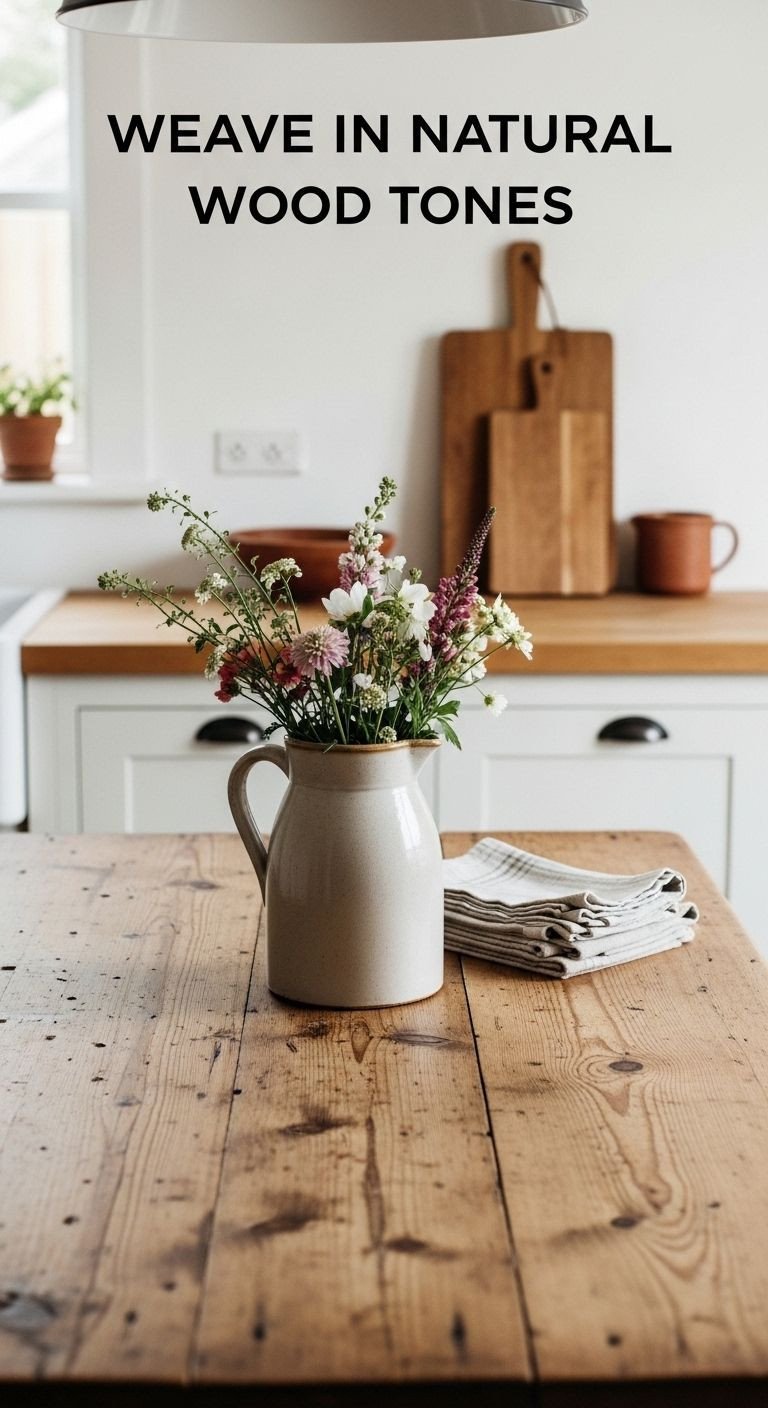
To ground the aesthetic and create an inviting atmosphere, it’s essential to incorporate warm, natural wood elements throughout the kitchen. This can be achieved through butcher block countertops, a distressed farmhouse dining table, open shelving, or even just a collection of well-loved wooden cutting boards leaning against the backsplash.
Here’s how to care for a butcher block countertop, a classic cottagecore feature:
- Materials Needed: Food-safe mineral oil or butcher block conditioner, soft cloths, fine-grit sandpaper (220-grit).
- Step-by-Step Directions:
- Ensure your butcher block countertop is clean and completely dry.
- Apply a generous amount of food-safe mineral oil or a specialized butcher block conditioner to the surface.
- Using a soft cloth, spread the oil evenly across the entire surface, including the edges.
- Let the oil soak in for at least 4-6 hours, or overnight if possible.
- Wipe away any excess oil with a clean, dry cloth. Repeat this process monthly to keep the wood from drying out and cracking.
Pro-Tip: Don’t be afraid to mix wood tones! A pine floor, oak table, and maple countertop can coexist beautifully. In my own kitchen, mixing woods added a sense of history and depth that a single tone just couldn’t achieve.
Share this cozy wood inspiration with a friend!
4. Display Thrifty Vintage Treasures
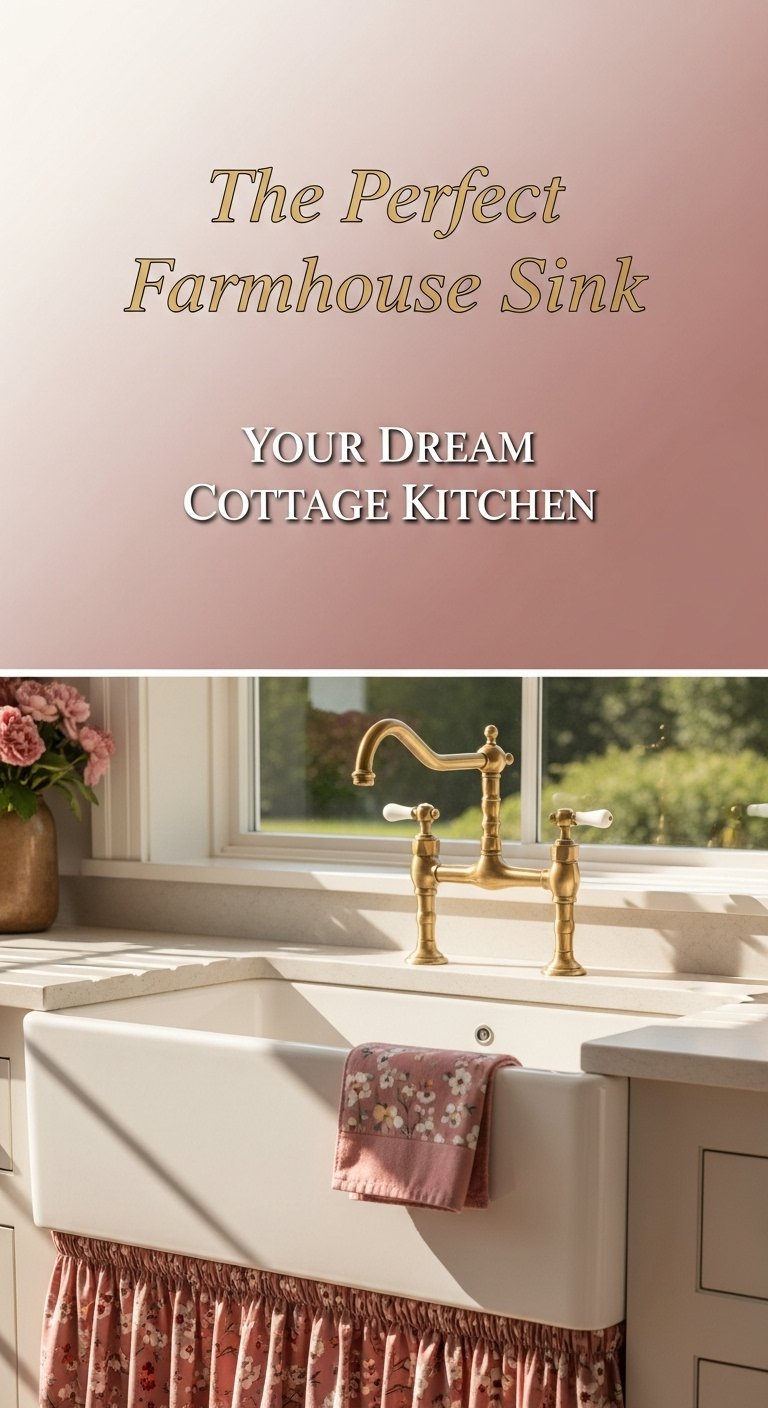
A key component of cottagecore is creating a sense of history, which you can do by decorating with affordable vintage items that add authentic character and a “collected over time” feel. Scouring thrift stores, flea markets, and antique shops for these treasures is part of the fun and ensures your kitchen is completely unique.
Here’s a checklist of cottagecore thrift store treasures to hunt for:
- Crockery & Enamelware: Look for mismatched floral plates, heavy stoneware mixing bowls, and chipped enamelware mugs or pitchers.
- Copper & Brass: Hunt for aged copper pots, brass candlesticks, or a vintage scale to use as a centerpiece on your island.
- Wooden Items: Search for well-worn wooden spoons, rolling pins, and cutting boards with lots of character and patina.
- Linens: Keep an eye out for embroidered tea towels, lace doilies, and floral tablecloths that might be hiding in a basket.
- Art: Find vintage botanical prints or simple landscape paintings in old, charmingly imperfect wooden frames.
Lesson Learned: The best finds are often a little imperfect. A small chip on a plate or a patina on a copper pot tells a story and adds to the authentic charm of the cottagecore aesthetic. I used to pass these by, but now I realize they’re the pieces that give a room its soul.
What’s your best thrift store find? Tell us in the comments!
5. Layer in Cozy Textiles & Floral Accents
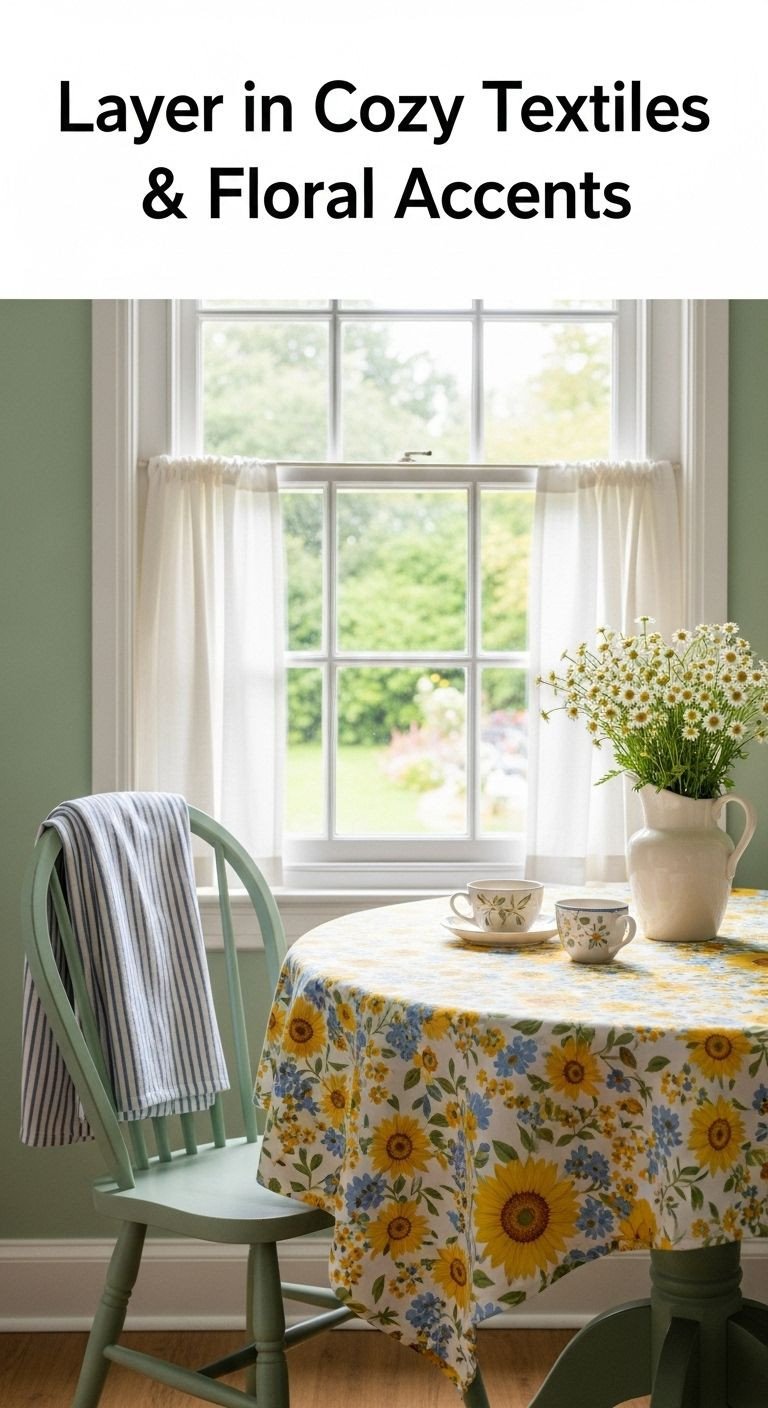
The easiest way to add instant softness, color, and pattern is to strategically layer textiles like curtains, rugs, tea towels, and tablecloths. This is where you can truly lean into the “cottage” feel by mixing quaint floral prints with simple stripes or gingham for a look that feels curated, not chaotic.
Here’s a simple formula for mixing patterns like a pro:
- Start with a Foundation: Choose a “hero” pattern for a major element, like a bold floral for cafe curtains or a tablecloth.
- Add a Supporting Pattern: Select a simpler pattern, like a stripe or gingham, for smaller items like tea towels or placemats in a complementary color.
- Incorporate Solids & Textures: Use solid-colored linen napkins, a simple woven jute rug, or lace doilies to break up the patterns and add tactile texture.
- Don’t Overdo It: Stick to a core color palette of 2-3 main colors to keep the look cohesive. For example, if your floral has blue, yellow, and green, pull those colors for your stripes and solids.
Pro-Tip: To make a bold floral wallpaper work in a kitchen without overwhelming it, I suggest using it on a single accent wall, perhaps in a breakfast nook, or even just as a liner for the back of a hutch. It provides maximum charm with minimal commitment.
Save this cozy nook idea for a weekend project!
6. Bring Nature Inside with Greenery & Herbs
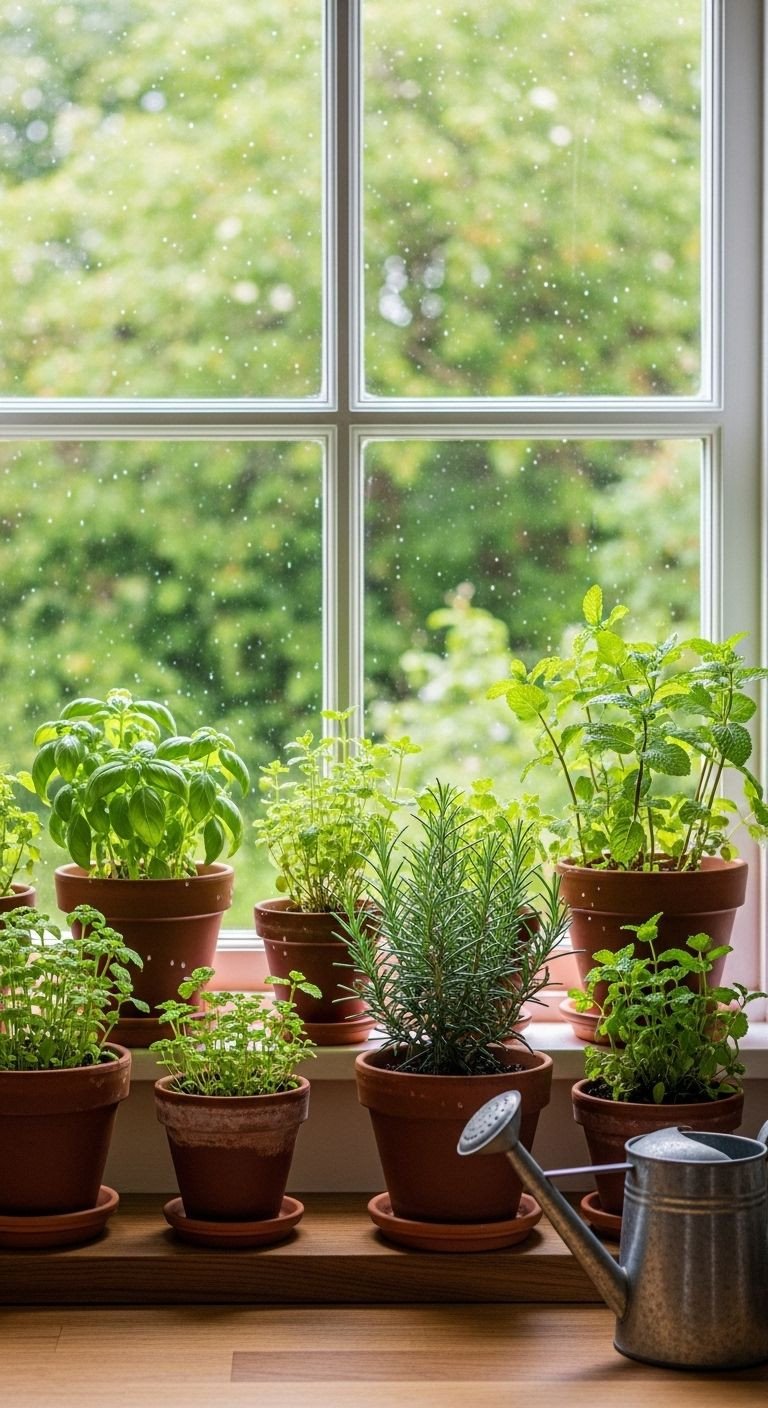
A core tenet of cottagecore is the connection to nature, so an essential step is to bring life and color into your kitchen with potted plants, a windowsill herb garden, and fresh flowers. Not only does this look beautiful, but having fresh herbs on hand is a practical delight for any home cook.
Here’s how to start a simple windowsill herb garden:
- Materials Needed: Terracotta pots, potting soil, herb seedlings (basil, rosemary, mint, thyme), small watering can.
- Step-by-Step Directions:
- Choose a Sunny Spot: Most herbs need at least 6 hours of direct sunlight per day, so a south-facing windowsill is ideal.
- Select Your Pots: Use simple terracotta pots with drainage holes. They are porous, which helps prevent root rot, and their earthy color is perfect for the aesthetic.
- Pot Your Herbs: Fill the pots with good-quality potting soil. Gently remove the herb seedlings from their store containers, loosen the roots, and plant them.
- Water Correctly: Water thoroughly after planting. Then, allow the soil to dry out slightly between waterings. Don’t overwater!
- Harvest Often: Regularly snipping leaves encourages the plants to become bushier and more productive.
Lesson Learned: In my experience, it’s best to start with easy-to-grow herbs like mint and basil. Their success will give you the confidence to try more finicky plants like rosemary or lavender down the line.
Pin this for a reminder to add some green to your space!
7. Paint Your Cabinets a Soft, Earthy Color
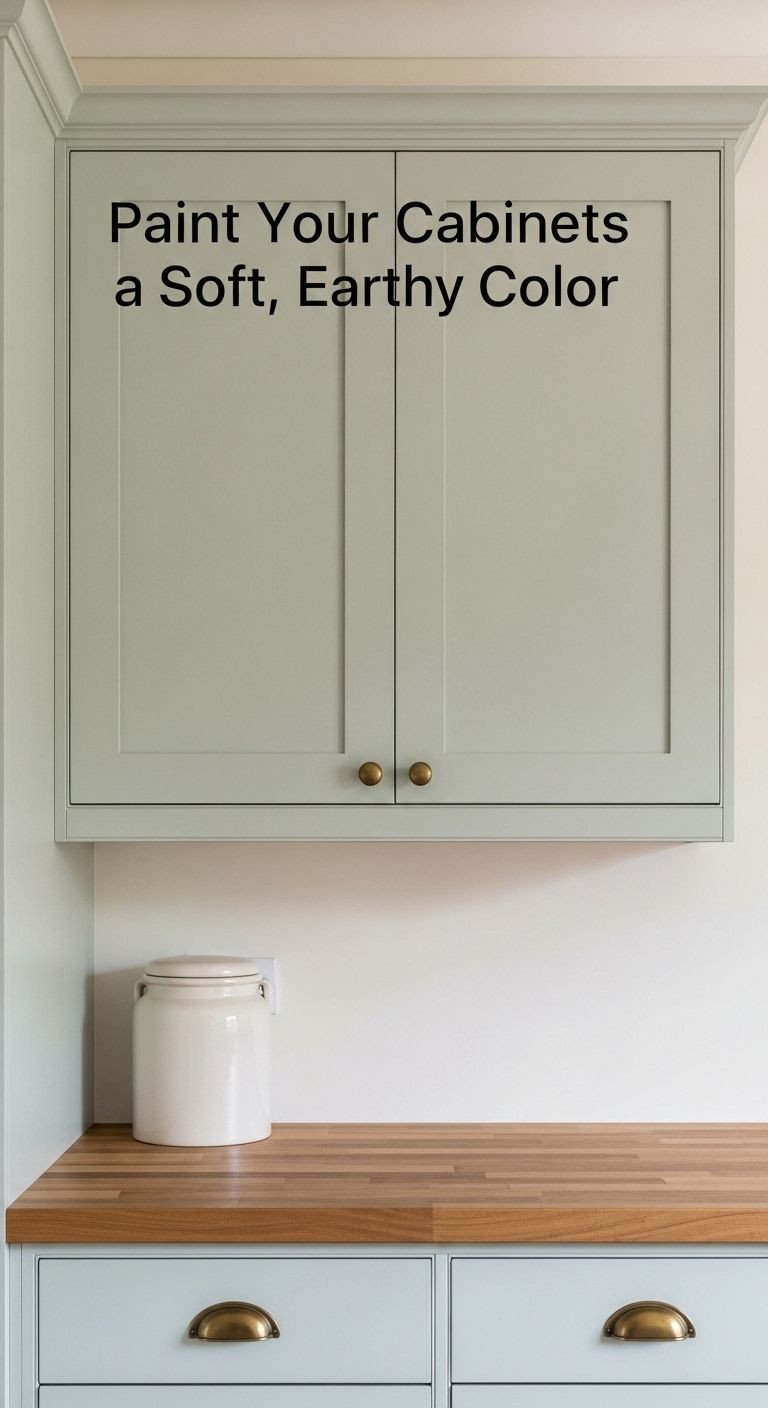
One of the most transformative updates you can make is to paint your kitchen cabinets in a soft, nature-inspired color like sage green, creamy white, or dusty blue. Moving away from stark white or dark wood and embracing a gentle, earthy hue in a matte or eggshell finish instantly softens the entire room and provides the perfect backdrop for your cottage decor.
Painting cabinets is a rewarding DIY project if you take your time.
- Materials Needed: Degreaser/cleaner, sandpaper (120 and 220 grit), high-quality primer, cabinet paint (in an eggshell or satin finish), paint brushes, small foam roller.
- Step-by-Step Directions:
- Prep is Key: Remove all doors, drawers, and hardware. Label everything with painter’s tape so you know exactly where it goes back.
- Clean Thoroughly: Clean all surfaces with a degreaser to remove any built-up kitchen grease and grime. This is the most important step!
- Sand Lightly: Lightly sand all surfaces with 120-grit sandpaper to scuff up the old finish, then wipe clean. This helps the primer adhere properly.
- Prime: Apply one to two coats of a high-quality bonding primer. Let it dry completely according to the can’s instructions.
- Paint: Apply two thin coats of your chosen cabinet paint, letting it dry fully between coats. Use a high-quality brush for detailed areas and a small foam roller for flat surfaces to minimize brush strokes.
Pro-Tip: Hardware is the jewelry of your cabinets. To complete the look, I always recommend choosing simple wooden knobs, antique brass cup pulls, or black iron latches. These small details make a huge difference in achieving an authentic cottage feel.
What color would you paint your cabinets? Let me know!
8. Hang Pots, Pans, and Mugs
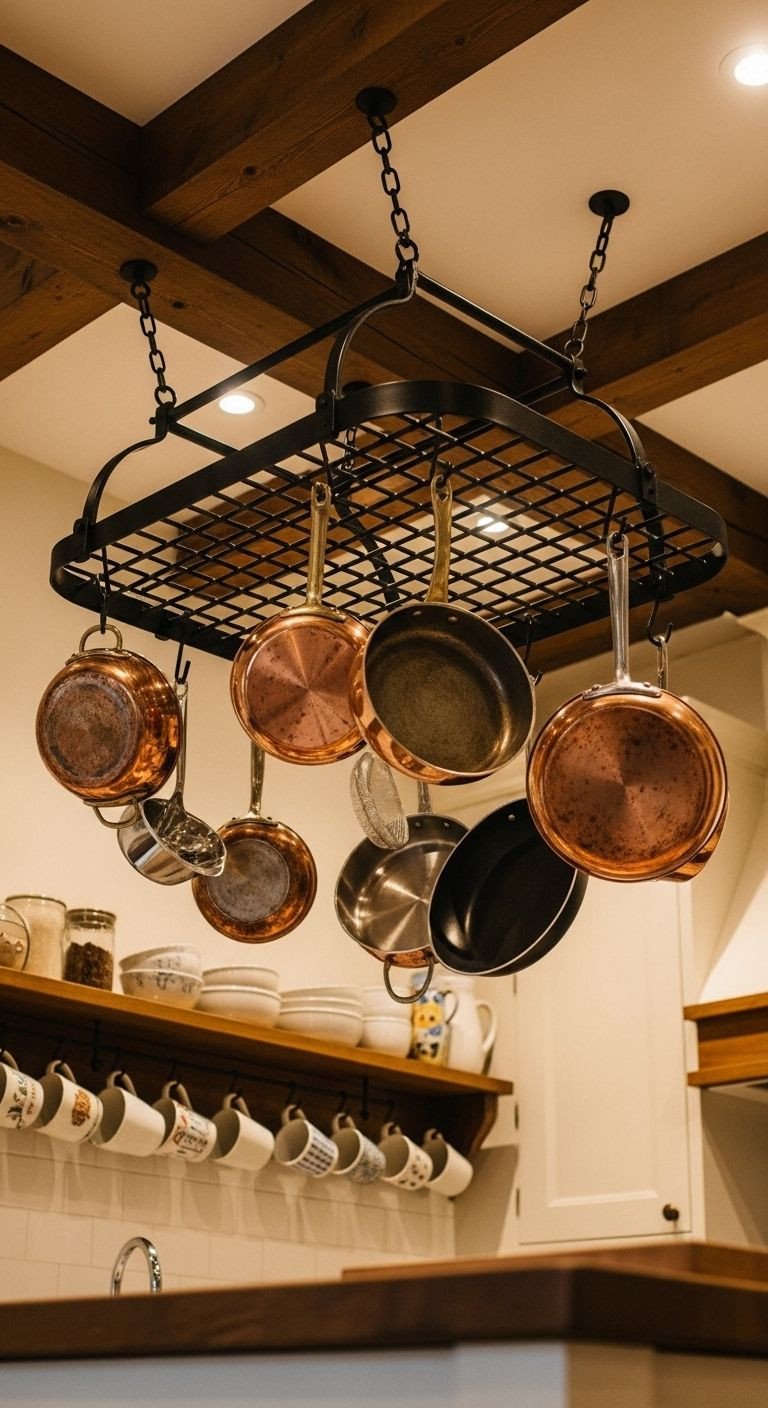
A true cottage kitchen feels like a well-loved workshop, so display your most beautiful and functional cooking essentials by hanging them from a pot rack or hooks. This approach celebrates the tools of the trade—gleaming copper pans, heavy cast iron skillets, and charming ceramic mugs—turning everyday items into part of the decor.
- Materials Needed: Ceiling or wall-mounted pot rack, S-hooks, stud finder, drill, heavy-duty mounting hardware.
- Step-by-Step Directions:
- Choose Your Rack: Select a style that fits your kitchen. Ceiling-mounted racks work well over islands, while wall-mounted bars are great for smaller spaces.
- Locate Joists/Studs: This is crucial for safety. Use a stud finder to locate the ceiling joists or wall studs. A rack full of pots is very heavy and must be securely anchored into solid wood.
- Mark and Drill: Mark your drilling locations and drill pilot holes.
- Mount the Rack: Securely attach the rack to the joists/studs using the heavy-duty hardware provided. Double-check that it is level and sturdy.
- Hang Your Items: Use S-hooks to hang your most-used (and most beautiful) pots and pans. For mugs, a simple shelf with hooks underneath is a perfect solution.
Lesson Learned: One thing I always tell people is to hang the heaviest items, like cast iron skillets, closer to the mounting points of the rack. This ensures better weight distribution and is much safer in the long run.
Tag someone who needs this practical and pretty storage idea!
9. Make Room for a Statement Hutch
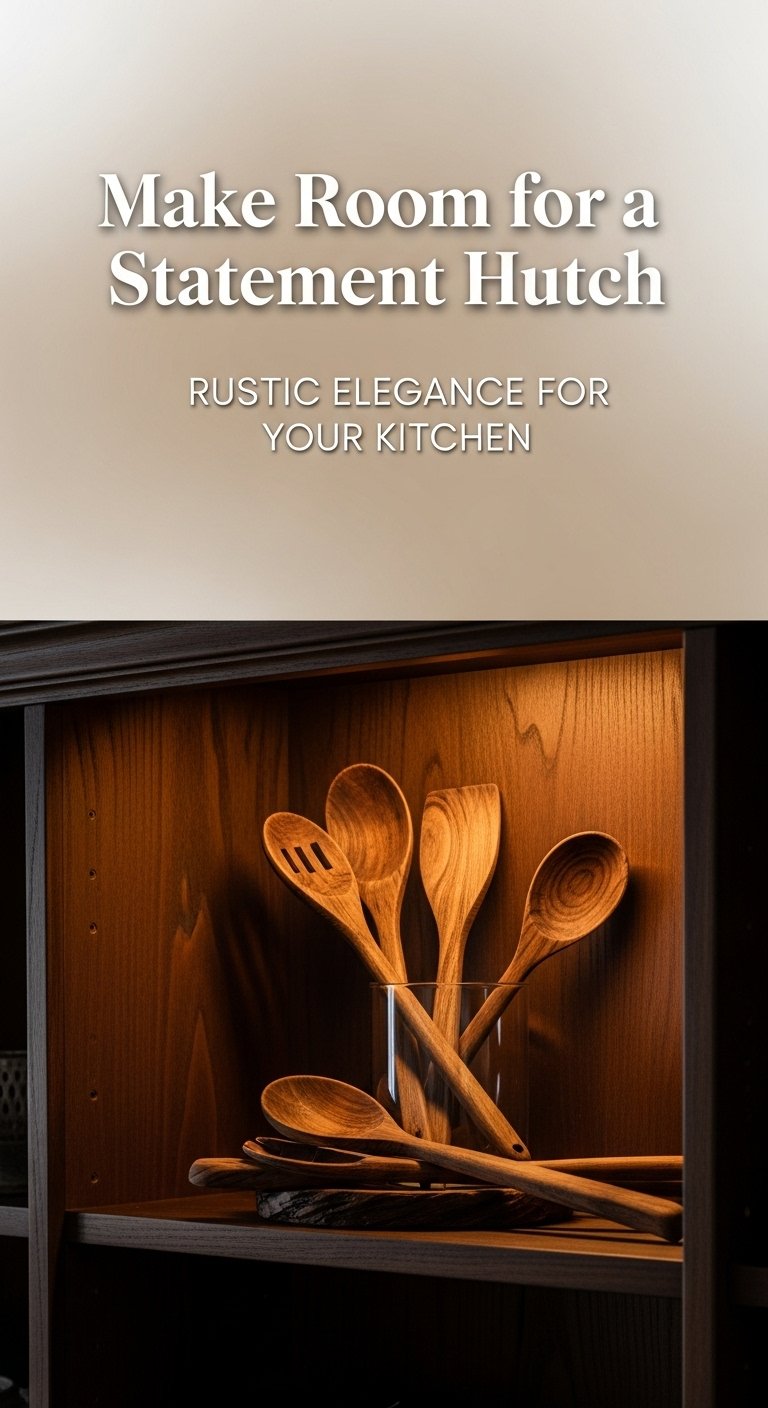
A freestanding hutch or Welsh dresser is a key furniture component that serves as both beautiful storage and a stunning focal point. It’s the perfect place to show off your collection of vintage china, stacks of linen napkins, and favorite cookbooks, creating a curated display that feels both elegant and homey.
Here’s how to style a hutch for that perfect cottagecore look:
- Materials Needed: A vintage or new hutch, your collection of pretty dishes, books, and decor items.
- Step-by-Step Directions:
- Source Your Hutch: Scour thrift stores, antique shops, and online marketplaces. Look for pieces with good bones; you can always paint them a creamy white or dusty blue.
- Start with an Anchor: Place your largest items first, like a stack of dinner plates or a large serving platter, in the center of the main shelves to create a focal point.
- Layer in Height & Texture: Add stacks of smaller plates, bowls, and teacups. Lean smaller plates against the back. Intersperse with cookbooks, small plants in terracotta pots, or woven baskets.
- Work in Triangles: Arrange items in groups of three at varying heights to create visual triangles, which is naturally pleasing to the eye.
- Step Back and Edit: Less is often more. Step back, assess the balance, and remove anything that makes it feel cluttered rather than curated.
Pro-Tip: My favorite trick is to line the back of the hutch with a charming floral wallpaper or simply paint it a contrasting color. This makes white and cream dishes really pop and adds an unexpected layer of detail.
Save this hutch styling inspo for later!
10. Dare to Go Dark & Moody
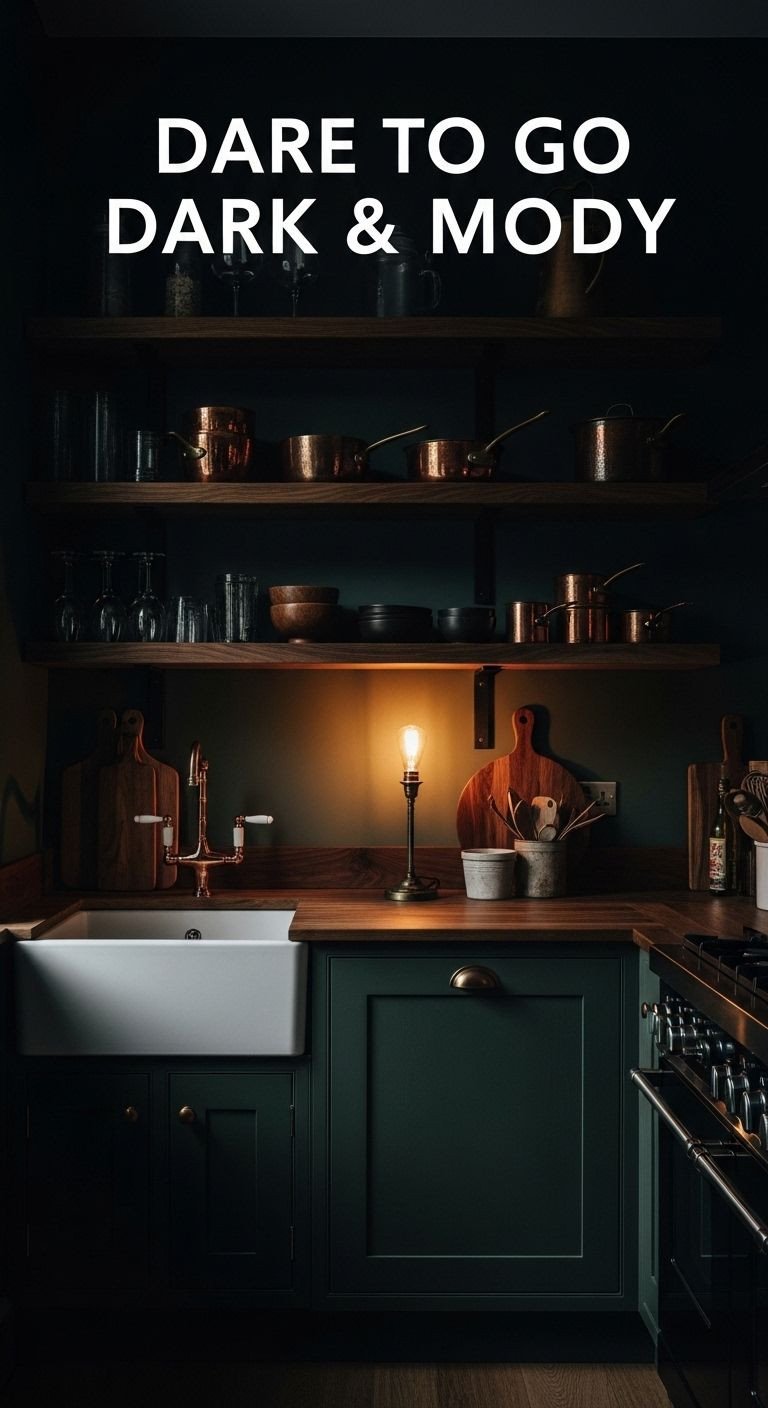
While cottagecore often brings to mind light and airy spaces, a modern evolution of the style is to embrace a dark, moody color palette with rich, earthy tones like forest green, navy, or charcoal. This creates a cozy, den-like atmosphere that is incredibly sophisticated and comforting, especially when balanced with warm wood and metallic accents.
- Materials Needed: Dark paint (deep forest green, navy, charcoal), warm metallic accents, good lighting fixtures.
- Step-by-Step Directions:
- Choose Your Dark Hue: Select a rich, earthy color like Farrow & Ball’s ‘Studio Green’ or a deep, moody blue. Don’t be afraid to paint the cabinets or even the walls for a full-immersion experience.
- Incorporate Warmth: Balance the darkness with lots of warm wood tones in your countertops, shelving, flooring, and furniture. This is essential to keep the space from feeling cold.
- Add Shine: Use warm metals like brass or copper for cabinet hardware, faucets, and light fixtures. The gleam will catch the light and prevent the space from feeling flat.
- Layer Lighting: A moody kitchen requires excellent layered lighting. Ensure you have good task lighting under cabinets, a beautiful pendant over an island, and perhaps a small vintage lamp on the counter for ambiance.
Lesson Learned: A dark cottagecore kitchen works best in a room with ample natural light. In my experience, the daylight prevents the dark colors from feeling oppressive during the day and instead highlights all the rich textures and finishes in the room.
Would you try a moody kitchen? Pin this if you dare!
11. Add Nostalgia with Vintage-Inspired Appliances
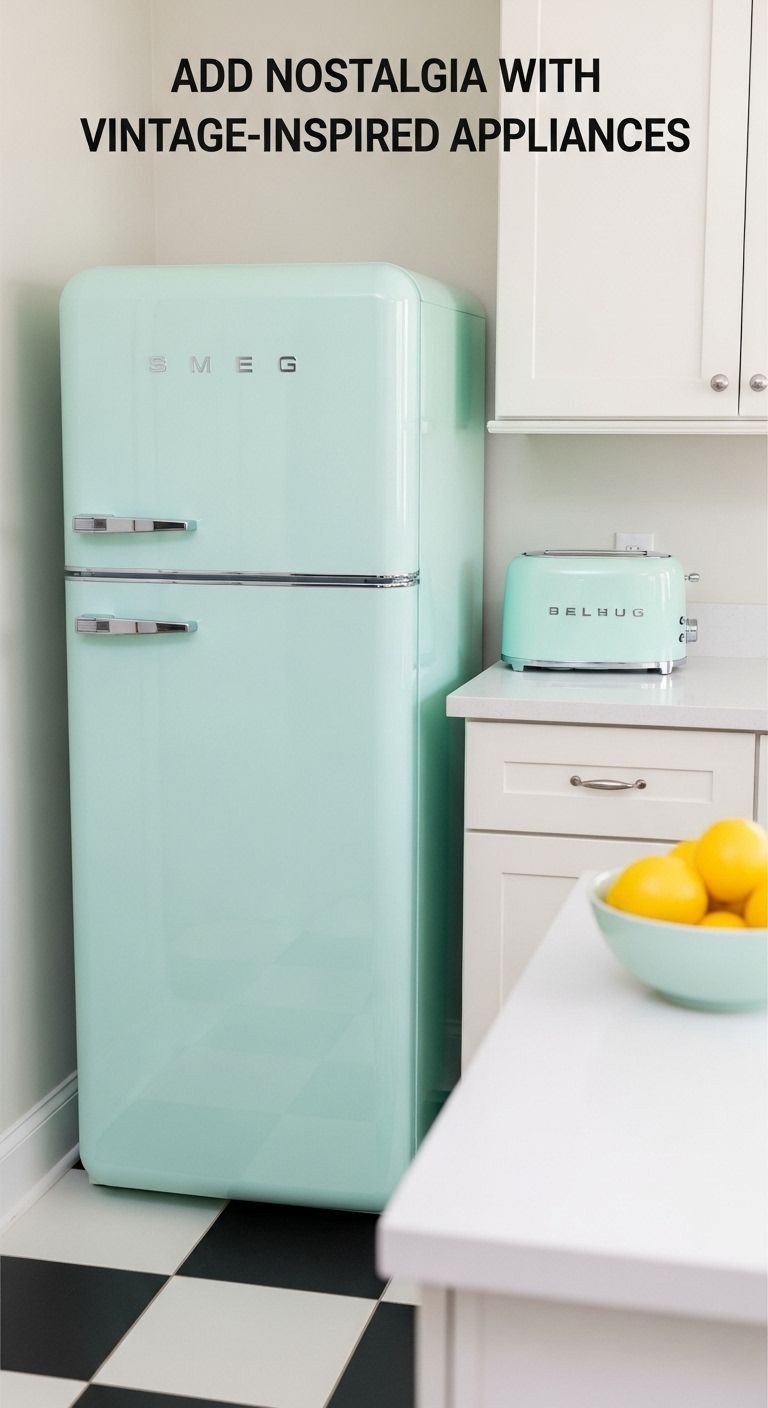
For a powerful dose of nostalgic charm, consider investing in a statement appliance with a retro design, like a colorful refrigerator or a vintage-style stove. These pieces serve as functional art, instantly setting a playful and nostalgic tone for the entire kitchen.
- Materials Needed: A budget and a vision for your statement appliance.
- Step-by-Step Directions:
- Choose Your Era: Decide on the aesthetic you love, whether it’s the rounded shapes and candy colors of the 1950s or the more ornate styles of the 1920s.
- Decide: True Vintage vs. Retro-Inspired: True vintage appliances can be beautiful but may require costly restoration and are often less energy-efficient. Modern retro-style appliances from brands like Smeg, Big Chill, or Gorenje offer the vintage look with all the benefits of modern technology.
- Pick a Color: This is your chance to add a joyful pop of color. Consider mint green, buttercup yellow, baby blue, or a classic creamy white.
- Build Around It: Let your statement appliance be the star. Keep the surrounding cabinetry and colors relatively simple to allow the retro piece to truly shine.
Pro-Tip: If a large retro appliance is out of your budget, you can get the same feel with smaller countertop appliances. A retro-style toaster, kettle, or stand mixer in a fun color can add a huge dose of nostalgic charm for a fraction of the cost.
Save this retro kitchen dream to your home decor board!
Key Takeaways: Your Quick Guide to a Dreamy Cottage Core Kitchen
Feeling inspired? Here are the core principles to remember as you begin your cottagecore kitchen journey.
- Embrace Natural & Imperfect: Prioritize natural materials like wood, linen, and stone. Don’t shy away from vintage finds with a bit of wear and tear—it adds character and soul.
- Layer Textures & Patterns: Mix wood grains, woven baskets, soft linens, and floral patterns to create a space that feels collected over time and uniquely yours.
- Function Meets Beauty: Display your everyday essentials. Hanging mugs, wooden spoons in a crock, and open shelving with your favorite dishes make the space feel lived-in and practical.
- Bring the Outside In: Never underestimate the power of fresh flowers from the garden, potted herbs on the windowsill, or even simple botanical prints on the wall to connect your home to nature.
- Make It Personal: The most important rule is that it should feel like you. Mix and match these ideas until your kitchen feels like a cozy, personal sanctuary.
People Also Ask About Cottage Core Kitchen Ideas
What is the best color for a cottage kitchen?
The best colors for a cottage kitchen are warm, earthy, and nature-inspired hues that create a soft and inviting atmosphere. Popular choices include soft sage green, creamy off-white, dusty rose, buttercup yellow, and muted blues. A neutral base allows vintage decor and natural wood tones to shine, while a pop of color on the cabinets can create a charming focal point.
How do I make my kitchen look cottagey on a budget?
You can make your kitchen look cottagey on a budget by focusing on cosmetic changes and DIY projects first. A fresh coat of paint on walls or cabinets can have a huge impact for little cost. Hunt for treasures at thrift stores—look for vintage dishes, wooden cutting boards, and floral linens. DIY projects like sewing a sink skirt or installing a simple beadboard backsplash are also budget-friendly ways to add instant cottage charm.
Is cottagecore still in style in 2025?
Yes, cottagecore is still very much in style in 2025 and has evolved from a fleeting trend into an enduring aesthetic. Its lasting popularity reflects a broader cultural shift toward sustainability, nostalgia, and the desire to create cozy, personal sanctuaries at home. The style now incorporates modern and moody twists, proving its adaptability and deep-rooted appeal.
Final Thoughts
Creating a cottagecore kitchen isn’t about following a rigid set of rules or achieving picture-perfect perfection. It’s about building a feeling—a sense of warmth, comfort, and simple joy. Your kitchen should be a reflection of what makes you happy, a personal haven for baking, gathering, and making memories.
We hope these ideas have inspired you to start creating the cozy, dreamy kitchen you’ve always wanted. Which idea are you most excited to try first? Let us know in the comments below
